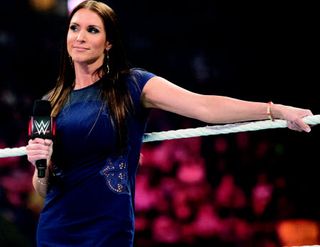Stephanie McMahon Shows Entreprenurial Moves

WWE chief brand officer Stephanie McMahon has arguably replaced her entrepreneurial father Vince McMahon as the face of the brand.
She’s worked with key executives to help push WWE’s brand footprint outside the ring, fostering the move into reality series with E!’s Total Divas and spinoff series Total Bellas, as well as expanding into digital with the 2014 launch of WWE Network.
Related > Flying High: How Wrestling Is Fueling TV Ratings [subscription required]
Showing off its financial muscle, WWE reported a 10% increase in revenue during first-quarter 2017 compared to the prior year. Further, the company said it “continues to target record financial results for 2017, specifically adjusted operating income of $100 million.”
SVOD service WWE Nework now has nearly 1.5 million global subscribers, according to the company, up 16% from first-quarter 2016. USA Network’s weekly WWE Monday Night Raw remains one of the most-watched series on cable, averaging more than 3 million viewers so far this year, while the Tuesday-night series WWE SmackDown has posted strong rating gains since its move from Syfy last year.
Multichannel News programming editor. R. Thomas Umstead spoke with McMahon last week via phone from London — where she and WWE were preparing for live telecasts of the May 8 Monday Night Raw and May 9 SmackDown — to get an overview of the thriving business as well as the challenges and opportunities that WWE faces. Here’s an edited transcript of their conversation.
MCN:What has propelled WWE’s strong performance in 2016 and thus far in 2017?
Stephanie McMahon: First of all, we have, you know, one of the best executive teams that we have had in a very long time. When you consider the fact that the WWE has grown into a $729 million business, things are working for us.
Nearly 30% of that revenue came from our international business, so that means our international expansion is working. In 2010 nearly 30% of our business was direct-to-consumer, and today it’s more than 50 percent, so our direct-to-consumer strategy is certainly working. In 2010, 6% of our business was digital, and today it’s more than 30%, so again it’s our businesses itself and the people driving it. They are laser-focused on our different strategies for growth, whether that be content and our tiered ecosystem, or sales and sponsorship.
But ultimately the secret sauce is truly our fan base. Our fans cheer, they boo, they chant … they actually help influence what happens in the ring. A lot of what we do is improv, and that’s where the performance art aspect comes in. Without our fan base, we don’t have a show, and that’s one of the reasons why social media has been so strong for WWE. We have over 780 million social media followers, which means their engagement with us continues outside of the ring. From a business standpoint we’re able to utilize the data analytics that we get from the WWE Network, from social media, from live events and even from merchandise sales to help influence the direction of our content and super-serve our audience.
MCN:In which areas of the business do you see the most growth potential in 2017?
SM: We’re really focused on international and we’re focused on content because again we want to super-serve our fan base through localized content. I was in Dubai just last week, announcing our first ever Arabic local-language show. We’re here in the U.K., where we’re shooting Monday Night Raw and SmackDown live at the O2 in London, where we’re also shooting localized content that will ultimately drive viewership into our NXT Takeover [episode] featuring the U.K. championship. So it really is localized content super-serving our fanbase in as many ways possible, along with international growth.
MCN:Having said that, what are the greatest challenges facing the WWE going forward?
SM: Well, I think the opportunities are the same as the challenges. From a technology standpoint we want to be able to offer fans everything that they’re asking for, and the biggest frustration comes when the technology just isn’t there yet to do it. But we’re constantly driving and pushing our partners to help make sure that that happens. Again, serving the appetite of our audience is really our greatest opportunity as well as our greatest challenge, because the more we provide them the hungrier they get.
MCN:Are you concerned at all about competition within the wrestling category given the proliferation of pro-wrestling content in the marketplace?
SM: Well I think imitation is the truest form of flattery, but I don’t think the viewership with some of those other organizations at this point is competition for us. If anything I think it just drives more interest in the genre itself. When you look at reality shows like Total Divas or Total Bellas, and when you look at films like our partnership with MGM for [theatrical film] Fighting With My Family, the story of [WWE wrestler] Paige’s life, I think we’re really just scratching the surface of the deeper stories that these individuals, as well as their characters, have to tell.
Multichannel Newsletter
The smarter way to stay on top of the multichannel video marketplace. Sign up below.
